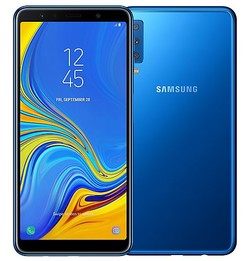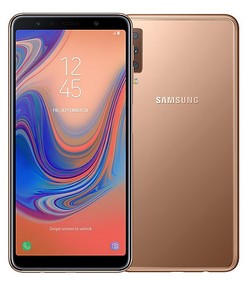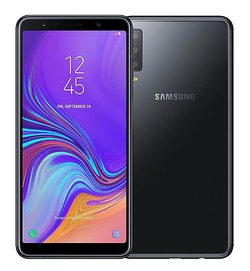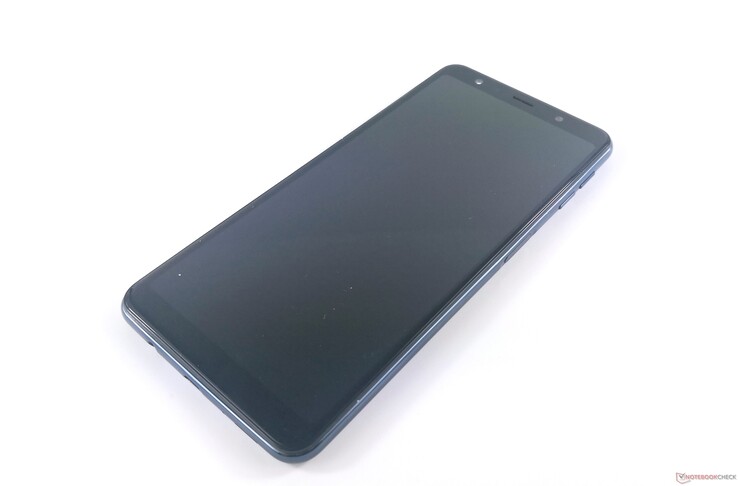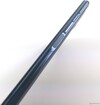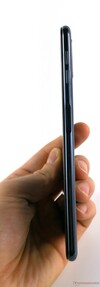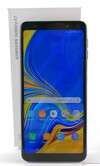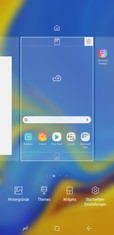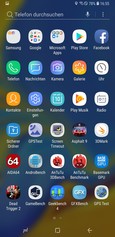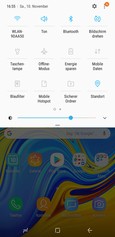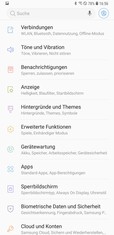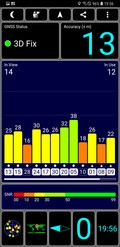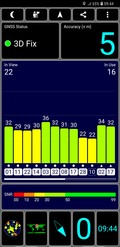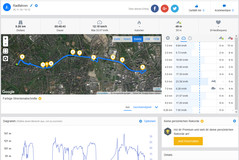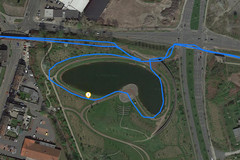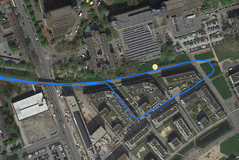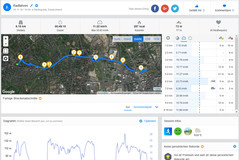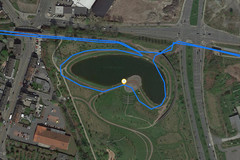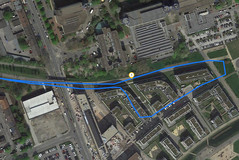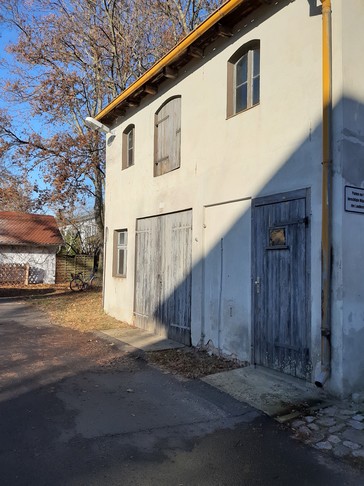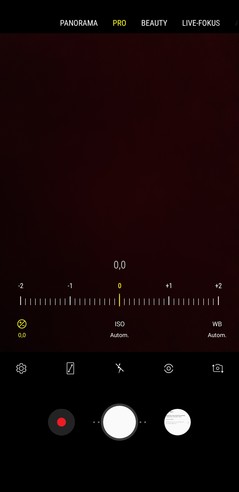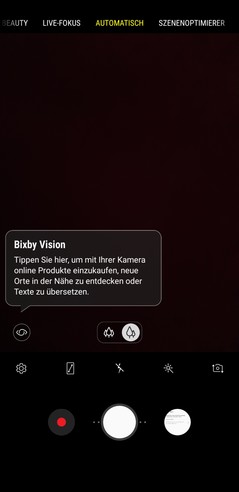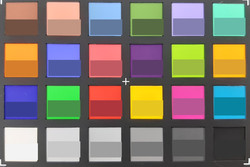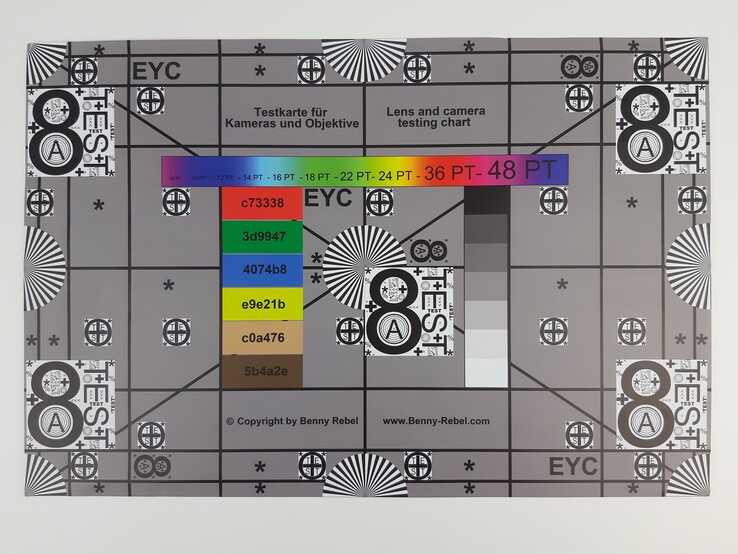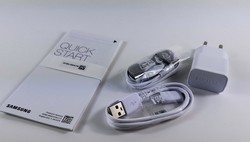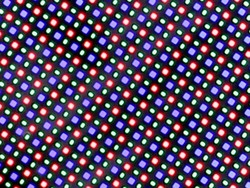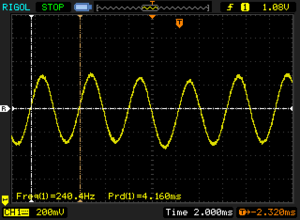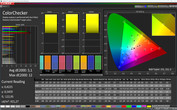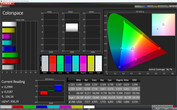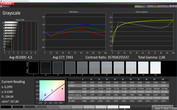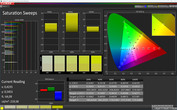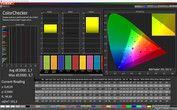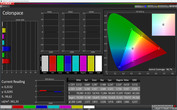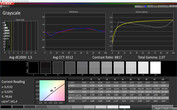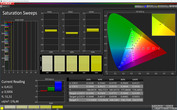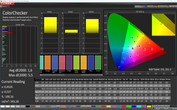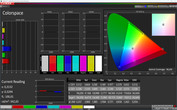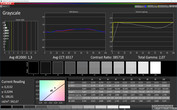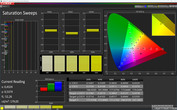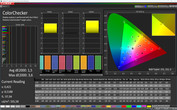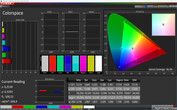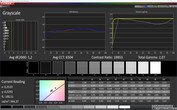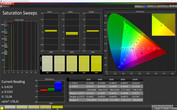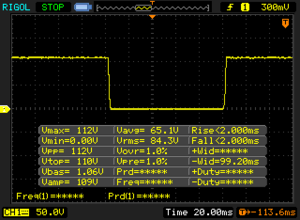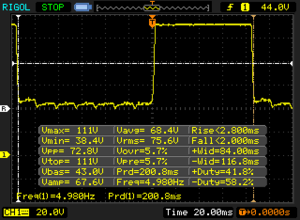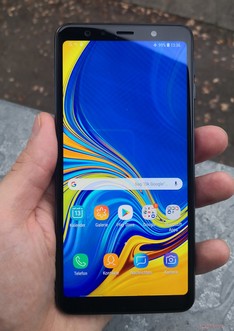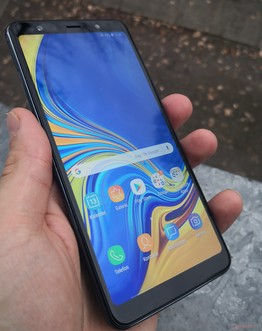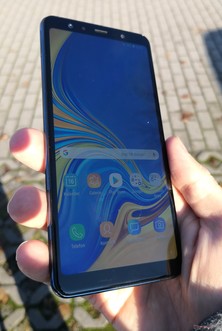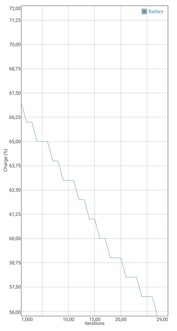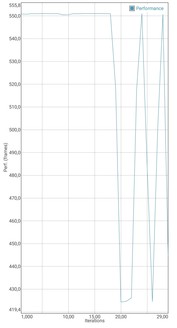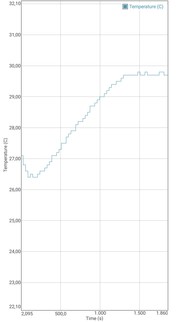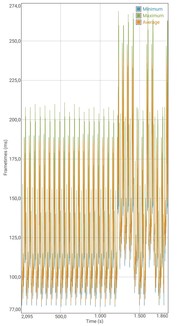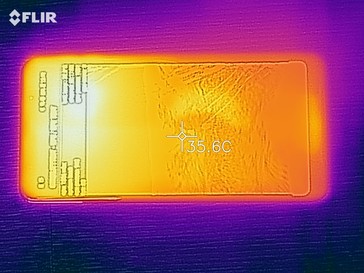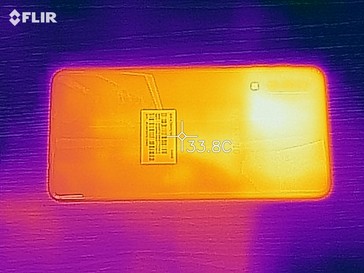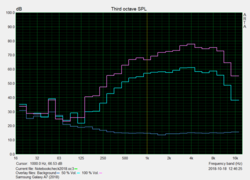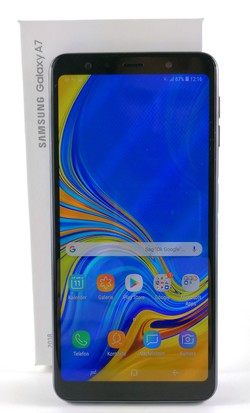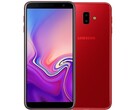Samsung Galaxy A7 (2018) Smartphone Review
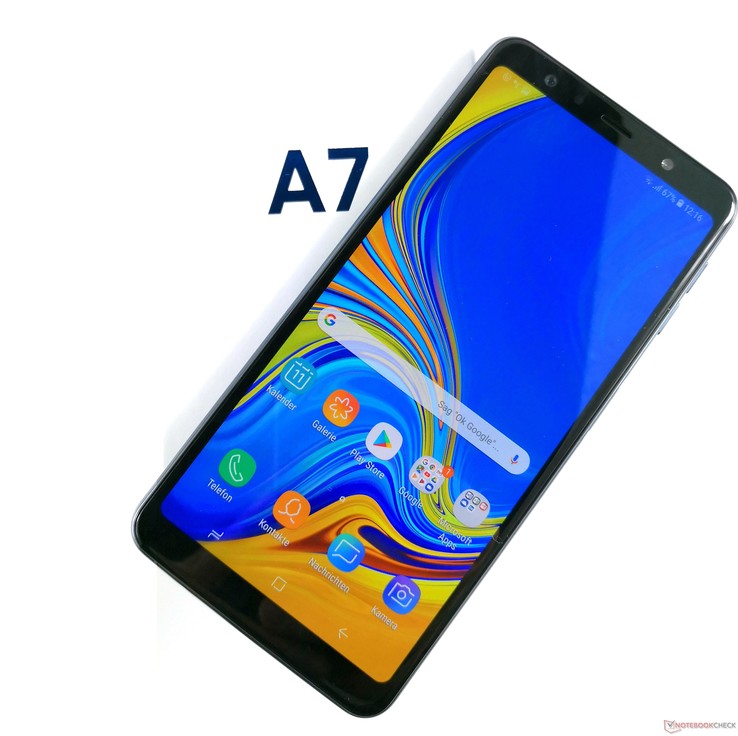
Samsung has gone down a new path with its own A series and is experimenting with the number of camera modules on the back of the device. With the Galaxy A7 (2018), users will have access to a wide-angle sensor, a powerful 24-MP main sensor with an aperture of f/1.7 and an additional 5-MP lens that enables the regulation of the depth of field and adjustment of bokeh effects at the time of recording.
Samsung has chosen an OLED panel for its A7 (2018). The 6-inch Super AMOLED panel in the Galaxy A7 (2018) has a native resolution of 2220x1080 pixels. It is powered by Samsung's own mid-range SoC Exynos 7885, which is equipped with either 4 or 6 GB of RAM. The internal storage can have a capacity of either 64 or 128 GB. However, only the 4/64 GB version is available at the time of writing. This was released at the end of September 2018 and is currently available for around £250 in the UK. Please note that the Samsung Galaxy A7 (2018) is not available for purchase in the US at the time of writing.
The mid-range smartphone segment is very well populated and the number of competitors is accordingly high. We have chosen the following smartphones as our comparison devices for this review: the Honor 8X, the Nokia 7 Plus, the Xiaomi Pocophone F1, the BQ Aquaris X2 and the Sony Xperia XA2. The price-to-performance champion Xiaomi Mi 6X is a little cheaper than the Samsung smartphone and is currently available for £200. We even found a competitor from within Samsung's Galaxy A series: the A8 (2018).
Case - Galaxy A7 (2018) with a plastic frame
The front of the Galaxy A7 (2018) consists of a scratch-resistant 2.5D display that is slightly curved and smoothly merges into the plastic frame. The OLED panel is surrounded by a wide frame on every side - there is no display notch. The screen-to-body ratio of only about 74% is not particularly efficient compared to the Honor 8X.
The phone weighs 168 grams and is only 7.5 mm high. It is nice to hold despite its relatively large dimensions (150x77 mm). The fingerprint reader is integrated into the power button placed on the side and is comfortable to use. The physical buttons are easily distinguished by feel thanks to different sizes and surfaces. The volume rocker is very well made and sits tight in the case with a well-defined pressure point. However, unlike the power button, the volume rocker is positioned a little too far up on the phone and is hard to reach. Also, the pressure point of the power button is rather spongy.
The back of the Galaxy A7 (2018) is also covered in slightly curved glass that shows up fingerprints quickly - particularly the black version that we tested. The phone is available in black, blue and gold. The triple camera on the back is not flush with the case, which makes the smartphone wobble when using it on a flat surface.
The stability of the mid-range smartphone is very good and even strong pressure hardly has an effect on the device. The Galaxy A7 (2018) cannot be warped, even with a lot of force. Overall, the case does not appear cheap despite having a plastic frame, although the Honor 8X with its metal frame does feel a little more valuable.
Connectivity - Samsung phone with 3.5-mm audio jack
The Galaxy A7 (2018) is equipped with a fingerprint reader, a status LED and an always-on function of the display for showing notifications. In addition, users can connect headphones via the 3.5-mm audio jack. Display content can be transferred wirelessly to an external monitor using Miracast. This worked well during our test with an Android TV from Sony.
Users of the Samsung smartphone will have to do without the modern USB Type-C port. The 3300-mAh battery is recharged using the old microUSB port on the bottom of the device. The port supports USB OTG for connecting external keyboards or USB sticks, though the speed is limited to the USB 2.0 standard.
The internal eMMC storage of our test unit has a capacity of 64 GB, although users only have 52 GB available for personal use after the initial setup. The dual-SIM smartphone's storage can be expanded using a microSD card (up to 512 GB). However, the SD card cannot be formatted as internal storage. The device supports the file system exFAT.
Software - Experience UI 9.0
Unlike with Android One or Pixel devices, the Galaxy A7 (2018) does not use Stock Android. The mid-range smartphone is equipped with Google's operating system Android 8.0 Oreo and the manufacturer's own user interface, Experience UI. The smartphone will probably receive an update to Android 9.0 Pie. However, this upgrade has not yet been officially announced. The security patches of our test unit were last updated in September 2018.
The Samsung user interface Experience UI 9.0 expands the Android software with optical modifications and some additional functions. The "Dual Messenger", for example, enables users to use two different accounts within one application. In addition, Samsung's virtual assistant Bixby can offer personalized information as well as timed and geographically bound reminders.
Compared to Stock Android, the device comes with a high amount of preinstalled apps. These third-party apps (bloatware) can only be deactivated, not uninstalled.
Communication and GPS - Samsung phone with NFC
Samsung has equipped our test unit with Bluetooth 5.0 and an NFC chip for near-field communication, which enables users to use the smartphone for paying via Google Pay.
The integrated Wi-Fi module in the Galaxy A7 (2018) supports the IEE 802.11 standards a/b/g/n/ac and uses both the 2.4 and 5-GHz band. The reception of the Wi-Fi module is good during everyday use and the signal remains stable. We measured an attenuation of -37 dBm at close proximity to the router (Telekom Speedport, W921V).
When connected to our reference router Linksys EA8500, our test unit reached good transfer rates of 279 Mb/s and 320 Mb/s. This means the Galaxy A7 (2018) can keep up with the best comparison devices in our test. Only the Pocophone F1 is in its own league.
The Samsung smartphone connects to mobile Internet with LTE category 6 and reaches download speeds of up to 300 Mb/s. The Galaxy A7 (2018) only supports seven LTE frequencies as well as quad-band GSM and quad-band UMTS.
The dual-SIM device offers space for two nano-SIM cards. Neither of the card slots is limited in its frequencies. The microSD slot is not connected to the SIM slots and can therefore be used even when using two SIM cards.
The device uses the satellite systems GPS, GLONASS, Galileo, Beidou and the satellite-based augmentation system SBAS. The device is quick to position us within five meters outdoors. Even indoors the Galaxy A7 (2018) manages to locate us quite quickly, although the precision drops to 13 meters here.
In order to test the precision of our test unit in practice, we take it on a bike ride together with the professional bike navigation system Garmin Edge 500. After a 9-km trip, the difference between the route tracked by our affordable mid-range smartphone and the professional navigator is only 70 meters.
The deviations from our route as tracked by the Galaxy A7 (2018) are minimal, which means that the mid-range smartphone is definitely suitable for use as a navigator when driving.
Telephone and Voice Quality - VoLTE and Wi-Fi Calling
The voice quality of the mid-range smartphone is very good as tested in the German Vodafone network. We did not encounter any dropouts or reception issues during our test period. Voices are reproduced clearly and our call partner also understood us very well. The smartphone supports modern standards such as VoLTE and Wi-Fi Calling.
The telephone app offers the usual Android features such as favorites, a call list and integrated contacts. The number pad allows you to input phone numbers manually.
Cameras - Samsung smartphone with triple camera
The main camera on the back of the Galaxy A7 (2018) has a resolution of 5664x4248 pixels and a 4:3 format. A dual LED supports the camera in bad lighting. While the 24-MP camera takes photos at a 77 ° standard angle, the 8-MP ultra-wide-angle lens records at an angle of 120 °, which corresponds to our natural field of vision. The third lens is a 5-MP sensor that enables the main camera to collect more depth of field information and determine the three-dimensionality of the main subject. This enables real-time bokeh effects and goes by the name of Live Focus.
The 24-MP camera module has a powerful aperture of f/1.7, which creates relatively light photos in dark surroundings. However, the photo quality is not much better than that of any other mid-range device. Bad lighting situations soon cause image noise and photos are characterized by artifacts and blurriness. Photos taken with the ultra-wide-angle lens turn out very dark and have a lot of noise due to the f/2.4 aperture.
The photo quality is good during daylight and image details and color reproduction are good, although photos taken with the Galaxy A7 (2018) always turn out a little pale in automatic mode. The contrast is slightly higher in the ultra-wide-angle mode. The dynamic range could be more pronounced overall, which would prevent the loss of some details in difficult lighting situations.
The 24-MP front camera has an f/2.0 aperture and takes good selfies during daylight, although they tend to be a little overexposed. Unfortunately, this camera does not support auto focus for ideal image sharpness. The front camera records videos in FHD resolution (1920x1080 pixels) at up to 30 fps. This also applies to the main camera on the back.
The camera software used in the Galaxy A7 (2018) offers 19 different scenes and automatically chooses suitable parameters for each photo. The scene optimization feature recognizes image content such as people or landscapes and adjusts color tones, brightness and contrast accordingly.
Colors are reproduced quite well under controlled lighting. As you can see below, all colors apart from greens are displayed relatively accurately compared to their reference colors, which are displayed in the bottom half of every field. Still, the picture taken of the X-Rite ColorChecker Passport (no post-processing such as manual white balance was done) with the 24-MP camera shows that the white balance is too warm. The colors also appear visibly lighter.
In order to measure the sharpness of photos, we took a photo of our test chart under controlled artificial lighting. The image sharpness is good in the image center, but photos become visibly blurry at the edges.
Accessories and Warranty - in-ear headphones included
The scope of delivery includes a modular 7.8-watt power supply (5 V, 55 A), a USB cable and a quick-start guide as well as in-ear headphones suitable for the 3.5-mm audio jack.
The manufacturer's warranty lasts 24 months after purchase. The warranty of the battery and power supply is limited to 12 months. Please see our Guarantees, Return policies and Warranties FAQ for country-specific information.
Input Devices & Handling - Galaxy A7 (2018) with FaceUnlock
The capacitive touchscreen responds precisely to inputs with up to 10 fingers. Its precision is good even at the edges of the screen and inputs are implemented without delay.
The Galaxy A7 (2018) can be navigated using the typical Android onscreen keys or by hiding the onscreen keys and using gesture control.
The virtual keyboard of the Galaxy offers nicely large keys thanks to the large display. The layout is customizable and the app offers a lot of optional settings.
The device can be unlocked via biometric identification using your fingerprint or face. The active fingerprint reader is integrated into the power button, which is positioned on the right side of the case. The reader works well and is reliable but takes some time to unlock the phone. The FaceUnlock function is similar. It works reliably but needs quite some time to recognize the face. The front camera cannot be used to unlock the Galaxy A7 (2018) in dark surroundings.
Display - Samsung phone with great OLED panel
The Super AMOLED display from Samsung has a diagonal of 6 inches. Its resolution of 2220x1080 pixels means that it has a pixel density of 441 ppi. Although current high-end smartphones offer a significantly higher number of pixels per inch, our mid-range smartphone seems to display even small writing very sharply nonetheless. The pixel structure is hardly noticeable during normal use and at an average distance to the screen.
The OLED panel reaches a high brightness level of 583 cd/m² when displaying a purely white panel. This makes the Galaxy A7 (2018) significantly brighter than most of its competition. Only the BQ Aquaris X2 can trump the brightness of our test unit. We also did a test with evenly distributed light and dark areas (APL50). Here, the brightness was 708 cd/m².
The phone uses pulse-width modulation (PWM) to control the brightness of the screen, even at its maximum. At brightness levels up to 99% the frequency of this flickering is rather low at 240 Hz.
| |||||||||||||||||||||||||
Brightness Distribution: 93 %
Center on Battery: 570 cd/m²
Contrast: ∞:1 (Black: 0 cd/m²)
ΔE ColorChecker Calman: 1.5 | ∀{0.5-29.43 Ø4.78}
ΔE Greyscale Calman: 1.2 | ∀{0.09-98 Ø5}
98.7% sRGB (Calman 2D)
Gamma: 2.07
CCT: 6504 K
| Samsung Galaxy A7 2018 Super AMOLED, 2220x1080, 6" | Samsung Galaxy A8 2018 Super AMOLED, 2220x1080, 5.6" | Nokia 7 Plus IPS, 2160x1080, 6" | Xiaomi Mi 6X LCD IPS, 2160x1080, 6" | Xiaomi Poco F1 IPS, 2246x1080, 6.2" | Honor 8X LCD IPS, 2340x1080, 6.5" | BQ Aquaris X2 IPS LCD, 2160x1080, 5.7" | Sony Xperia XA2 IPS, 1920x1080, 5.2" | Samsung Galaxy S8 Super AMOLED, 2960x1440, 5.8" | |
|---|---|---|---|---|---|---|---|---|---|
| Screen | -84% | -101% | -173% | -91% | -191% | -124% | -170% | -48% | |
| Brightness middle (cd/m²) | 570 | 541 -5% | 458 -20% | 459 -19% | 489 -14% | 484 -15% | 631 11% | 513 -10% | 566 -1% |
| Brightness (cd/m²) | 565 | 538 -5% | 463 -18% | 441 -22% | 486 -14% | 469 -17% | 622 10% | 506 -10% | 564 0% |
| Brightness Distribution (%) | 93 | 96 3% | 92 -1% | 91 -2% | 93 0% | 93 0% | 96 3% | 93 0% | 94 1% |
| Black Level * (cd/m²) | 0.22 | 0.47 | 0.34 | 0.55 | 0.61 | 0.42 | |||
| Colorchecker dE 2000 * | 1.5 | 5.8 -287% | 4 -167% | 5.8 -287% | 3.8 -153% | 7.3 -387% | 5.5 -267% | 5 -233% | 2.7 -80% |
| Colorchecker dE 2000 max. * | 3.6 | 7.4 -106% | 10.7 -197% | 7.1 -97% | 11.1 -208% | 8.5 -136% | 11.4 -217% | 5.4 -50% | |
| Greyscale dE 2000 * | 1.2 | 2.7 -125% | 4.7 -292% | 7.3 -508% | 4.4 -267% | 7.4 -517% | 5.6 -367% | 7.8 -550% | 3.1 -158% |
| Gamma | 2.07 106% | 2.07 106% | 2.19 100% | 2.28 96% | 2.22 99% | 2.16 102% | 2.38 92% | 2.2 100% | 2.15 102% |
| CCT | 6504 100% | 6570 99% | 7425 88% | 7984 81% | 7213 90% | 8534 76% | 7531 86% | 7964 82% | 6335 103% |
| Contrast (:1) | 2082 | 977 | 1438 | 880 | 1034 | 1221 | |||
| Color Space (Percent of AdobeRGB 1998) (%) | 81.57 | ||||||||
| Color Space (Percent of sRGB) (%) | 99.87 |
* ... smaller is better
Screen Flickering / PWM (Pulse-Width Modulation)
| Screen flickering / PWM detected | 240.4 Hz | ≤ 99 % brightness setting | |
The display backlight flickers at 240.4 Hz (worst case, e.g., utilizing PWM) Flickering detected at a brightness setting of 99 % and below. There should be no flickering or PWM above this brightness setting. The frequency of 240.4 Hz is relatively low, so sensitive users will likely notice flickering and experience eyestrain at the stated brightness setting and below. In comparison: 53 % of all tested devices do not use PWM to dim the display. If PWM was detected, an average of 8108 (minimum: 5 - maximum: 343500) Hz was measured. | |||
Due to their technology, OLED panels have a significant advantage compared to IPS panels. These displays are able to display complete blackness even in a dark room and at maximum brightness. This means that in theory the contrast ratio of the Galaxy A7 (2018) tends towards infinity.
Our analysis using the spectrophotometer and the CalMAN software results in a low average DeltaE deviation of the sRGB color space of 1.5 for colors and 1.3 for grayscales (see photo below). The ideal range of these values is below 3. The measured results are very good considering the device's price range.
The color temperature is very precise at 6504 K compared to an ideal value of 6500 K. The OLED panel covers the color spaces we measured (sRGB, AdobeRGB, P3) almost entirely. We did not notice a particular color cast.
Display Response Times
| ↔ Response Time Black to White | ||
|---|---|---|
| 4 ms ... rise ↗ and fall ↘ combined | ↗ 2 ms rise | |
| ↘ 2 ms fall | ||
| The screen shows very fast response rates in our tests and should be very well suited for fast-paced gaming. In comparison, all tested devices range from 0.1 (minimum) to 240 (maximum) ms. » 15 % of all devices are better. This means that the measured response time is better than the average of all tested devices (20.2 ms). | ||
| ↔ Response Time 50% Grey to 80% Grey | ||
| 4.8 ms ... rise ↗ and fall ↘ combined | ↗ 2.8 ms rise | |
| ↘ 2 ms fall | ||
| The screen shows very fast response rates in our tests and should be very well suited for fast-paced gaming. In comparison, all tested devices range from 0.165 (minimum) to 636 (maximum) ms. » 15 % of all devices are better. This means that the measured response time is better than the average of all tested devices (31.6 ms). | ||
Performance - Samsung Exynos 7885 has some everyday weaknesses
The Samsung Exynos 7885 was first presented at the beginning of 2018 in the Samsung Galaxy A8 2018. The SoC has two Cortex A73 cores that clock at a maximum of 2.2 GHz as well as six energy-efficient Cortex A53 cores with a clock rate of 1.6 GHz. The Exynos 7885 is produced using the (old) 14-nm FinFET process. The graphics card is an ARM Mali-G71 MP2.
The system performance of our test unit does not seem to be up to par with its competitors. Despite the rather powerful Exynos 7885 the system does not always run smoothly during everyday use. We often encountered judders and lags, particularly while multitasking. Closing and opening applications also seemed to go rather slowly. Even the Honor 8X with its weaker HiSilicon Kirin 710 offers better system performance.
The Samsung processor gives a similar impression during our benchmarks. The Exynos 7885 reaches similar results to the Qualcomm Snapdragon 636 in the BQ Aquaris X2. Particularly during the graphics-intensive GFXBench benchmark, our test unit was not able to keep up with its Qualcomm competition. We also noticed rather low results in PCMark, which evaluates the general system performance. This corresponds with our personal impression of the phone.
There is a large difference between the benchmark results of the Xiaomi Pocophone F1 equipped with a Snapdragon 845 and a Qualcomm Adreno 630 and the Galaxy A7 (2018).
The browser speed is very decent using the preinstalled Chrome browser. The device loads complex websites quickly and navigation is smooth for the most part. The Samsung smartphone also did a good job in our browser benchmarks. The performance difference between the Mozilla Kraken 1.1 benchmark and the other benchmarks is striking.
| JetStream 1.1 - Total Score | |
| Xiaomi Poco F1 (Chrome 68) | |
| Nokia 7 Plus (Chrome 60) | |
| Xiaomi Mi 6X (Chrome 67) | |
| Samsung Galaxy A8 2018 (Chrome 64.0.3282.137) | |
| Average Samsung Exynos 7885 (48 - 49.1, n=2) | |
| Samsung Galaxy A7 2018 (Chrome 70) | |
| Honor 8X (Chrome 70) | |
| BQ Aquaris X2 (Chrome 67) | |
| Sony Xperia XA2 (Chrome 65.0.3325.109) | |
| Octane V2 - Total Score | |
| Average of class Smartphone (2228 - 121337, n=201, last 2 years) | |
| Xiaomi Poco F1 (Chrome 68) | |
| Nokia 7 Plus (Chrome 60) | |
| Xiaomi Mi 6X (Chrome 67) | |
| Samsung Galaxy A8 2018 (Chrome 64.0.3282.137) | |
| Average Samsung Exynos 7885 (9165 - 9350, n=2) | |
| Samsung Galaxy A7 2018 (Chrome 70) | |
| Honor 8X (Chrome 70) | |
| BQ Aquaris X2 (Chrome 67) | |
| Sony Xperia XA2 (Chrome 65.0.3325.109) | |
| Mozilla Kraken 1.1 - Total | |
| Sony Xperia XA2 (Chrome 65.0.3325.109) | |
| Xiaomi Mi 6X (Chrome 67) | |
| BQ Aquaris X2 | |
| Samsung Galaxy A8 2018 (Chrome 64.0.3282.137) | |
| Honor 8X | |
| Average Samsung Exynos 7885 (4123 - 4275, n=2) | |
| Samsung Galaxy A7 2018 (Chrome 70) | |
| Nokia 7 Plus (Chrome 60) | |
| Xiaomi Poco F1 (Chrome 68) | |
| Average of class Smartphone (257 - 28190, n=156, last 2 years) | |
| WebXPRT 3 - Overall | |
| Average of class Smartphone (38 - 380, n=34, last 2 years) | |
| Nokia 7 Plus (Chrome 60) | |
| Xiaomi Mi 6X (Chrome 67) | |
| Honor 8X (Chrome 70) | |
| Samsung Galaxy A7 2018 (Chrome 70) | |
| Average Samsung Exynos 7885 (n=1) | |
| BQ Aquaris X2 (Chrome 67) | |
| WebXPRT 2015 - Overall | |
| Xiaomi Poco F1 (Chrome 68) | |
| Xiaomi Mi 6X (Chrome 67) | |
| Nokia 7 Plus (Chrome 60) | |
| Samsung Galaxy A7 2018 (Chrome 70) | |
| BQ Aquaris X2 (Chrome 67) | |
| Average Samsung Exynos 7885 (156 - 168, n=2) | |
| Samsung Galaxy A8 2018 (Chrome 64.0.3282.137) | |
| Honor 8X (Chrome 70) | |
| Sony Xperia XA2 (Chrome 65.0.3325.109) | |
* ... smaller is better
The storage device used in the Galaxy A7 (2018) is not the fastest. Samsung has given its mid-range smartphone an eMMC flash storage instead of the more modern UFS variant. The AndroBench benchmark shows that it has a particular weakness when writing data.
The integrated microSD card slot is comparable to its competition. We measured its speed with our reference card, the Toshiba Exceria Pro M501 (max read: 270 MB/s, max write: 150 MB/s). The card reader's performance is average at 78 MB/s (reading) and 64 MB/s (writing).
| Samsung Galaxy A7 2018 | Samsung Galaxy A8 2018 | Nokia 7 Plus | Xiaomi Mi 6X | Xiaomi Poco F1 | Honor 8X | BQ Aquaris X2 | Sony Xperia XA2 | Average 64 GB eMMC Flash | Average of class Smartphone | |
|---|---|---|---|---|---|---|---|---|---|---|
| AndroBench 3-5 | -2% | 15% | 5% | 39% | 51% | 3% | -6% | 24% | 1159% | |
| Sequential Read 256KB (MB/s) | 295.8 | 299.9 1% | 283.1 -4% | 272 -8% | 705 138% | 283.9 -4% | 270.5 -9% | 271.5 -8% | 277 ? -6% | 2226 ? 653% |
| Sequential Write 256KB (MB/s) | 104.9 | 104.2 -1% | 211.6 102% | 203.7 94% | 155.6 48% | 170 62% | 188.7 80% | 127.4 21% | 178.4 ? 70% | 1848 ? 1662% |
| Random Read 4KB (MB/s) | 84 | 82.6 -2% | 54.7 -35% | 73 -13% | 101 20% | 49.54 -41% | 43.9 -48% | 43.07 -49% | 60.7 ? -28% | 295 ? 251% |
| Random Write 4KB (MB/s) | 15.45 | 14.69 -5% | 19.62 27% | 6.89 -55% | 17.81 15% | 59.9 288% | 14.4 -7% | 13.82 -11% | 33.8 ? 119% | 335 ? 2068% |
| Sequential Read 256KB SDCard (MB/s) | 78.2 ? | 77.9 ? 0% | 82.2 5% | 85.3 ? 9% | 75.2 ? -4% | 82.9 ? 6% | 86 ? 10% | 77.4 ? -1% | ||
| Sequential Write 256KB SDCard (MB/s) | 64.4 ? | 62.3 ? -3% | 62.3 -3% | 65.6 ? 2% | 68.1 ? 6% | 62.3 ? -3% | 64.8 ? 1% | 58.3 ? -9% |
Games - Mali-G71 manages current games
The ARM Mali-G71 is an entry-level GPU. Its MP2 version, which is used in the Galaxy A7 (2018), only has two of the 32 possible graphics cores available. The GPU is based on Bifrost architecture and supports OpenGL ES 3.2, Vulkan 1.0, OpenCL 2.0 and RenderScript.
GPU performance is good enough to display current games in native 1080p resolution. Using the GameBench app, we measured 29 fps during the racing game Asphalt 9 at high settings. The rather demanding ego shooter PUBG Mobile can also be displayed at an average of 29 fps at maximum graphics settings, although we did notice occasional drops in the frame rate here.
Both the touchscreen and the sensors in the Samsung phone work well. However, the mono speaker is slightly covered when holding the device in landscape mode.
Emissions - the Galaxy A7 2018 produces little excess heat
Temperature
The back of the Galaxy A7 (2018) has a rather uneven heat pattern. While we measured average temperatures way under 30 °C while idling, the back reached a maximum surface temperature of 35.8 °C under load.
The heat development on the front of the device is higher but quite heterogenic. Waste heat should not pose a problem during everyday use, but you can feel some heat when running more-demanding applications.
We ran the battery test of the GFXBench app in order to check the behavior of the Samsung smartphone under continuous load. The Manhattan 3.1 tests show that increasing load causes the temperature to rise significantly while the frame rate drops after round 16 out of 30 runs. The fluctuations are within a range of about 25%. This means that it is quite possible for the performance to drop under load and confirms that the performance capacities of our Galaxy A7 (2018) is variable.
(+) The maximum temperature on the upper side is 34.8 °C / 95 F, compared to the average of 35.2 °C / 95 F, ranging from 21.9 to 247 °C for the class Smartphone.
(+) The bottom heats up to a maximum of 35.8 °C / 96 F, compared to the average of 34 °C / 93 F
(+) In idle usage, the average temperature for the upper side is 27.1 °C / 81 F, compared to the device average of 32.9 °C / 91 F.
Speaker
As expected, the sound pattern of the Galaxy A7 (2018) consists mostly of middle and high frequencies. The Pink Noise diagram shows that bass tones are hardly audible but that mids and highs are quite linear.
The speaker is decent enough for a mid-range smartphone and reaches a good maximum volume of 85 dB(A). The audio port is also sufficiently loud and produces a clean sound. As the device has a 3.5-mm audio jack, users can use "normal" headphones without having to connect an adapter.
Samsung Galaxy A7 2018 audio analysis
(+) | speakers can play relatively loud (85.5 dB)
Bass 100 - 315 Hz
(-) | nearly no bass - on average 27.5% lower than median
(±) | linearity of bass is average (10.4% delta to prev. frequency)
Mids 400 - 2000 Hz
(+) | balanced mids - only 3.6% away from median
(+) | mids are linear (4.8% delta to prev. frequency)
Highs 2 - 16 kHz
(±) | higher highs - on average 8.2% higher than median
(+) | highs are linear (3.3% delta to prev. frequency)
Overall 100 - 16.000 Hz
(±) | linearity of overall sound is average (22.3% difference to median)
Compared to same class
» 46% of all tested devices in this class were better, 7% similar, 47% worse
» The best had a delta of 11%, average was 35%, worst was 134%
Compared to all devices tested
» 64% of all tested devices were better, 6% similar, 30% worse
» The best had a delta of 4%, average was 24%, worst was 134%
Xiaomi Mi 6X audio analysis
(+) | speakers can play relatively loud (84.1 dB)
Bass 100 - 315 Hz
(-) | nearly no bass - on average 27.6% lower than median
(±) | linearity of bass is average (9.7% delta to prev. frequency)
Mids 400 - 2000 Hz
(+) | balanced mids - only 3.3% away from median
(+) | mids are linear (5.3% delta to prev. frequency)
Highs 2 - 16 kHz
(+) | balanced highs - only 2.7% away from median
(+) | highs are linear (4% delta to prev. frequency)
Overall 100 - 16.000 Hz
(±) | linearity of overall sound is average (19.1% difference to median)
Compared to same class
» 24% of all tested devices in this class were better, 9% similar, 67% worse
» The best had a delta of 11%, average was 35%, worst was 134%
Compared to all devices tested
» 45% of all tested devices were better, 7% similar, 48% worse
» The best had a delta of 4%, average was 24%, worst was 134%
Battery Runtime - Samsung phone with good runtimes
Power Consumption
The Galaxy A7 (2018) is an efficient smartphone. Of all our comparison devices only the Sony Xperia XA2 has significantly better power consumption rates. However, the Samsung Galaxy A8 (2018) can offer slightly better rates with similar hardware. Consumption could be lower under load.
| Off / Standby | |
| Idle | |
| Load |
|
Key:
min: | |
| Samsung Galaxy A7 2018 3300 mAh | Samsung Galaxy A8 2018 3000 mAh | Nokia 7 Plus 3800 mAh | Xiaomi Mi 6X 3010 mAh | Xiaomi Poco F1 4000 mAh | Honor 8X 3750 mAh | BQ Aquaris X2 3100 mAh | Sony Xperia XA2 3300 mAh | Average Samsung Exynos 7885 | Average of class Smartphone | |
|---|---|---|---|---|---|---|---|---|---|---|
| Power Consumption | 21% | -9% | -7% | -15% | -24% | -14% | 19% | 10% | -23% | |
| Idle Minimum * (Watt) | 0.71 | 0.67 6% | 0.65 8% | 0.65 8% | 0.65 8% | 0.92 -30% | 0.65 8% | 0.39 45% | 0.69 ? 3% | 0.848 ? -19% |
| Idle Average * (Watt) | 1.36 | 1.02 25% | 1.76 -29% | 1.94 -43% | 1.97 -45% | 2.3 -69% | 2.24 -65% | 1.61 -18% | 1.19 ? 12% | 1.434 ? -5% |
| Idle Maximum * (Watt) | 1.47 | 1.1 25% | 1.78 -21% | 1.97 -34% | 2.01 -37% | 2.32 -58% | 2.26 -54% | 1.62 -10% | 1.285 ? 13% | 1.618 ? -10% |
| Load Average * (Watt) | 5.13 | 3.86 25% | 4.47 13% | 4.65 9% | 4.29 16% | 4.37 15% | 3.87 25% | 3.12 39% | 4.5 ? 12% | 7.01 ? -37% |
| Load Maximum * (Watt) | 7.89 | 5.97 24% | 9.13 -16% | 5.93 25% | 9.05 -15% | 6.13 22% | 6.8 14% | 4.92 38% | 6.93 ? 12% | 11.3 ? -43% |
* ... smaller is better
Battery Runtime
The Samsung Galaxy A7 (2018) has a 3300-mAh battery. The mid-range smartphone reached a battery runtime of 10 hours during our Wi-Fi test with display brightness set to 150 cd/m², which is quite good. The Galaxy A7 (2018) also keeps going quite long under load with a measured runtime of 4.5 hours. The included 7.8-watt power supply recharges the device in about 2.5 hours. The phone recharges to 50% capacity in about an hour.
| Samsung Galaxy A7 2018 3300 mAh | Samsung Galaxy A8 2018 3000 mAh | Nokia 7 Plus 3800 mAh | Xiaomi Mi 6X 3010 mAh | Xiaomi Poco F1 4000 mAh | Honor 8X 3750 mAh | BQ Aquaris X2 3100 mAh | Sony Xperia XA2 3300 mAh | |
|---|---|---|---|---|---|---|---|---|
| Battery runtime | 4% | -8% | -26% | 17% | 41% | 2% | 30% | |
| Reader / Idle (h) | 24.5 | 25.8 5% | 28.4 16% | 17.4 -29% | 34.8 42% | 41.7 70% | ||
| H.264 (h) | 13.9 | 15.1 9% | 11.8 -15% | 10.1 -27% | 15.6 12% | 12.8 -8% | ||
| WiFi v1.3 (h) | 10.1 | 10.8 7% | 11.2 11% | 8.3 -18% | 13.5 34% | 14.2 41% | 10.3 2% | 14.8 47% |
| Load (h) | 4.6 | 4.3 -7% | 2.6 -43% | 3.2 -30% | 3.7 -20% | 5 9% |
Pros
Cons
Verdict - display benchmark in the mid-range segment
The Samsung Galaxy A7 (2018) excels in our test with its great Super AMOLED panel that can become very bright, has extremely precise color reproduction and it has stable viewing angles. On top of that, it has good contrasts thanks to the perfect black value that is typical for OLED screens. All in all, this is a display that has no equal in this price range.
We are less impressed by Samsung's own mid-range processor. The Exynos 7885 shows several weaknesses when dealing with everyday workloads during our test. The system performance of the Samsung SoC cannot keep up with its Qualcomm competition. The Honor 8X equipped with the new HiSilicon Kirin 710 can also offer a more consistent everyday performance.
The Galaxy A7 (2018)'s figurehead is its triple camera, which offers great versatility and decent photo quality. The ultra-wide angle and Live Focus function give users interesting options, although the latter function can be a little disappointing sometimes.
Like with the Honor 8X, we are left wondering why Samsung has decided to equip its 2018 model with an old microUSB standard. This does not make sense, particularly considering that the Galaxy A5 from 2017 was already equipped with a USB Type-C port.
Display lovers will not get around the Samsung Galaxy A7 (2018) if they are looking for a suitable device in the mid-range price segment.
There are a lot of interesting alternatives in this mid-range segment. For example, the powerful Pocophone F1 or the significantly cheaper price-to-performance champion Xiaomi Mi A2. Should the price for the Samsung Galaxy A7 (2018) drop slightly, its great display and wide-angle camera options still make it a worthwhile alternative.
Samsung Galaxy A7 2018
- 11/19/2018 v6 (old)
Marcus Herbrich




